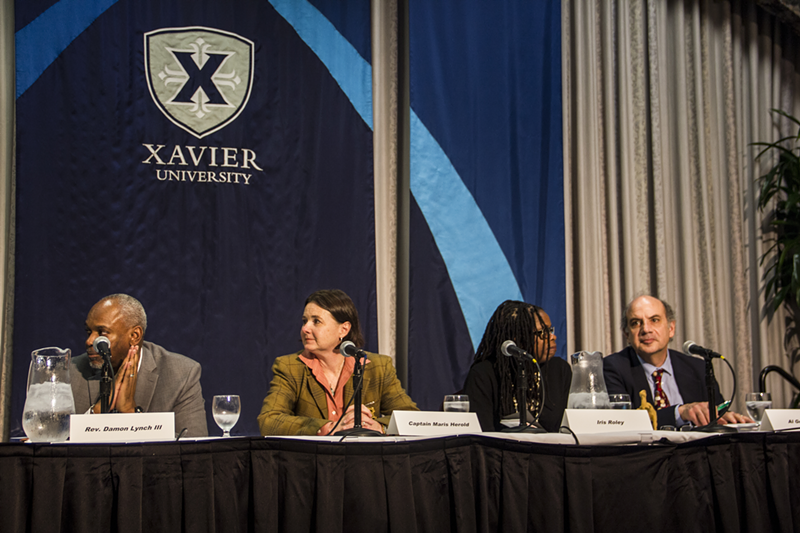Xavier University held a packed town hall discussion last night on the state of Cincinnati 15 years after the police shooting of unarmed black citizen Timothy Thomas and the civil unrest that shook the city afterward.
Thomas was the 15th black Cincinnatian killed by police during the previous three years, and frustrations in the black community over those killings, and deep economic and social isolation, bubbled over in Over-the-Rhine and other neighborhoods around the city.
Even after a decade and a half, the town hall was as timely as ever: Last summer saw the death of unarmed black motorist Samuel DuBose at the hands of University of Cincinnati police officer Ray Tensing, and events in the past year and a half across the country have brought the issue of racially charged police violence front and center. As evidenced by the sometimes-contentious discussion last night, frustration remains even as Cincinnati has enacted some meaningful reforms in its approach to policing.
Charlie Luken, who was Cincinnati's mayor in 2001, gave introductory remarks to the crowd. Luken admitted that officials at the time were slow to pay attention to the signs of unrest.
“Our community, including me, was slow to grasp the depths of legitimate complaint," he said.
Luken said he doesn't condone violence but also called the unrest in 2001 “part of the American tradition.” He said activism during the unrest led to positive change, a significant shift from statements he made in 2001 when he remarked that “some of them seem to be out here just for the fun of it.”
Activist Iris Roley of the Black United Front argued that the historic Collaborative Agreement that came after the unrest by federal order was a positive step, but that much more work is still needed. For example, Roley advocated for expanded community presence for the Citizen’s Complaint Authority, which handles citizens’ complaints against officers under the city’s police reforms. In 2014, the last year for which data was available, complaints about discrimination rose by 100 percent from the year prior. Complaints about excessive use of force rose 30 percent and firearm discharge allegations rose by 60 percent. Only improper pointing of a firearm complaints went down, by 67 percent. Overall, allegations rose 39 percent over 2013, though those percentages are somewhat skewed by the small numbers involved. Of the 320 complaints filed with the authority, 67 were investigated.
"Children want to know what the people did for them," Roley said of Collaborative Agreement, which she says is still very relevant now. Still, “policing is so huge in the black community. I wish we could think about other things," Roley said, and, "it's more stressful now" because much of police oversight work is done at the city level, and less is in the hands of activists.
Rev. Damon Lynch III, a pastor in OTR in 2001 whose church has since moved to Roselawn, said police issues are just a part of the city’s race problem and that much of the rest of the racial disparity, including huge socioeconomic gaps, haven’t shifted in Cincinnati since 2001.
"Childhood poverty won't start the next civil unrest," he said, suggesting that the economic issues that set up those conditions are the real issue.
Civil rights attorney Al Gerhardstein echoed Roley in his analysis that the Collaborative Agreement was a good step and that strategies like problem-oriented policing are better than previous law enforcement techniques even if larger systemic problems keep racial disparities in place.
“The original ask (in 2001) from my clients was addressing economic inequity,” Gerhardstein said of the fight the Black United Front and other activists waged in court over police reforms following Thomas’ death. “You can't sue capitalism. That's a problem."
Cincinnati Police Department District 4 Capt. Maris Harold, meanwhile, maintained that policing in Cincinnati has gotten remarkably better in the last two decades, touting what she calls the data-driven “science of policing,” which she says can result in fewer arrests by targeting the few violent criminals in an area.
“Policing is a paramilitary organization," and thus, all about strategy, Harold said. That strategy before 2001 was, "zero tolerance, arrest everything that moves," Harold said, but, “unless you're an irrational person, you have to realize the strategy wasn't working." She says police have since realized a small number of people commit violence and that to be effective they must narrow in on those individuals.
Black Lives Matter activist Brian Taylor, however, argued that a shift in police tactics can’t mask deeper problems and that the most powerful way to address those inequalities is through street-level activism. If policing is paramilitary, Taylor asked, “Who is the enemy? Racism is institutional, bound to the system on a molecular level." Taylor brought up the fact that officers who corroborated Tensing’s story around the shooting of DuBose this summer are still on the force and what he says are lingering questions around the CPD shooting of Quandavier Hicks last summer in Northside.
Audience members had loads of questions surrounding the deeper issues that sparked the unrest in 2001, including socioeconomic inequalities and lack of jobs and educational opportunities in the black community.
Many audience members also decried what they see as the inequitable development of Over-the-Rhine, which came about during the years following the unrest when then-mayor Luken helped put together the Cincinnati City Center Development Corporation. 3CDC and other developers have subsequently spent nearly $1 billion redeveloping OTR, in the process changing parts of the neighborhood from a low-income community into a more upscale enclave.


